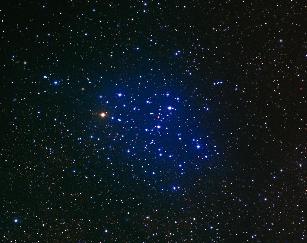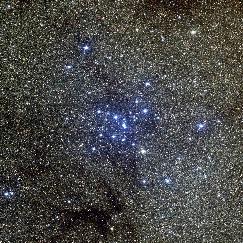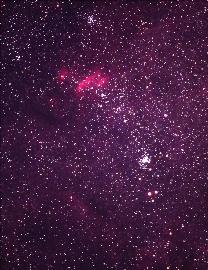Scorpius
M6 - Open Cluster
M6 - Ptolemy's Cluster
The Northern Jewelbox - Open Clusters and Diffuse Nebula
Scorpius, with its tail arching below Sagittarius, includes Antares, the 13th brightest star in the sky. An irregular variable, its brightness varies from 1.02 to 0.86 magnitudes. Note that the constellation is called Scorpius not Scorpio - as used by astrologers! It lies in the plane of the Milky Way galaxy and is thus rich in both globular and open star clusters. Four of the latter are included in the A-List. It is low in the south for northern observers during summer, but high in the winter skies for those in the southern hemisphere.
M7 Open Cluster E B L
M6 is a cluster of about 120 stars that suggests the outline of a butterfly with open wings. The brightest stars in the cluster are of magnitudes 6 to 7, with 60 greater than 11th magnitude. The brighter stars are blue-white with the exception of the very brightest of all; a yellow-orange semi-regular variable star that alters in brightness from 7 up to 5.5 magnitudes every 850 days or so. It makes a very nice colour contrast with the blue-white stars around it. Overall, the visual magnitude of the cluster is 4.2 so it should be easily visible to the unaided eye under dark skies. It lies 4.5 degrees north-west of M7 (see below) and is probably found most easily in binoculars or finder scope by scanning north-west from M7 when both will be seen in the same field of view. M6 extends over an area some 20 arc minutes across; two- thirds the angular diameter of the Moon. Its distance is difficult to estimate due to the obscuration of light by the dust in the Milky Way but is approximately 1600 light years away, which would make the cluster extend across a volume of space 12 light years in diameter. It is estimated to be 100 million years old.
Position: 17h 40.1m -32deg 13min
M7- Ptolemy's Cluster Open Cluster E B L
This is by far the most obvious cluster in Scorpius, standing out in a very bright region of the milky way. Just imagine that the 'teapot' of Sagittarius, to the north-east, was pouring tea. M7 is just where you would put the cup! It is obvious in binoculars and, with an overall visual magnitude of 3.3, easily visible to the unaided eye. A splendid cluster, it was mentioned by Ptolemy in 130AD and it has been suggested recently that it be named after him – an excellent idea. The cluster contains about 80 stars spread over an angular field 80 arc minutes across and all shine brighter than 10th magnitude. Its brightest member is a yellow giant of 5th magnitude and a dozen or so are brighter than 7th magnitude. It is thought to be over twice as old as its neighbour M6, which makes it about 220 million years old.
Position 17h 53.9m -34deg 49min
C76 - The Northern Jewel Box Diffuse nebula and Open Clusters B L M
This is a name given to yet another wonderful region of the milky way at the western-end of the tail of the scorpion, almost due south of Epsilon Scorpii. Sweep south from Epsilon Scorpii by approximately two binocular fields of view, passing on the way a pair of 3rd magnitude stars Mu 1 and Mu 2 and stop as Zeta Scorpii, another double star system, enters the field of view. Interestingly, Zeta is one of the most luminous stars in our galaxy - over 100,000 times as bright as our Sun! Just north of Zeta Scorpii is a bright and compact open cluster NGC 6231, north-east of which are two loose open clusters Cr 316 and Tr 24 - numbers 316 and 24 respectively in the catalogues of clusters compiled by P. Collinder and R. J. Trumpler in the 1930s. Continuing north is the second compact cluster NGC 6242. A bright region of nebulosity called IC4268 lies just to the north of the loose clusters. This region has all the appearances of a comet - the 'tail' arching north-west away from the 'coma' formed by NGC 6231 - so the region is also called the 'False Comet' Nebula. It marks one of the Milky Way's nearby spiral arms, some 6000 light years distant. NGC 6231 is very young cluster, perhaps 3.2 million years old. This is indicated by the fact that its brightest star is an O-type star of apparent magnitude 4.7. Such stars burn up their fuel very quickly and so have very short (but dramatic) lives!
Position: 16h 54.2m -41deg 50min






